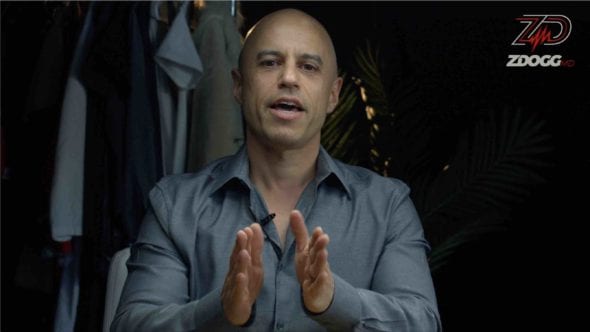CDC reports a possible association between the Johnson & Johnson COVID-19 vaccine and a type of autoimmune paralysis called Guillain-Barre. Here’s what you need to know.
Okay, so CDC is coming out saying scary neurological condition is associated potentially with Johnson & Johnson coronavirus vaccine. What do we need to know about it? What’s the deal with Guillain-Barre syndrome? It’s got a beautiful name, doesn’t it? All right, here’s the thing. First of all, let’s talk about what that is, and then we’ll talk about the vaccine and its association with this, whether it’s real, what it means for you in terms of risk, right? About 12 or 13 million Americans so far have gotten the Johnson & Johnson vaccine. The beauty of that vaccine is it’s a single shot and it’s a different type of technology than the mRNA technology.
It’s a human adenovirus that doesn’t cause disease, that’s replication defective, so you inject a bunch of this adenovirus that contains the DNA instructions for how to make spike protein that your cells then make you mount an immune response to the spike protein. And then that’s how the vaccine works. You’re then ready to go when wild-type COVID shows up, you’ve already gotten immune clone army ready to attack. Now, one of the interesting things about this that makes it different than the mRNA vaccines, which have not been yet associated with Guillain-Barre syndrome, which we’re gonna talk about, is that it uses an actual virus. Now, this becomes very important because so does the AstraZeneca vaccine. It uses a chimpanzee adenovirus vector to deliver the genetic instructions. The mRNA vaccines don’t. They just use the mRNA wrapped in a lipid nanoparticle, so they’re different in that way and this becomes important.
Why? Well, Guillain-Barre syndrome, it’s actually not one thing. It’s a series of different sub-syndromes that are kind of lumped together. They each have slightly different mechanisms. But it kinda works like this. It’s an autoimmune condition where your own immune system attacks your peripheral nerves. So not your brain and stuff directly, but the nerves that come off the spinal cord and brain, the peripheral nervous system, PNS. These nerves consists of axons, which are the long fibers that are wrapped or encased in myelin, which is kind of like the plastic coating on a wire. It’s an insulation that allows signals along that axon, electrical signals, impulses to travel faster. So all that being said, your immune system can attack either the myelin coating, that insulation, or the axon itself. So there’s kind of sub-variants and they show up in different ways. Now, historically Guillain-Barre syndrome affects something like 6,000 Americans a year, so it’s not fully rare, but it’s still quite uncommon. And the way that it manifests is in kind of a, it’s mostly a motor issue. So in other words, you can have weakness all the way from just mild weakness to paralysis, but there’s sometimes a sensory component, too. So it mostly affects these motor neurons, but there’s a sensory component in terms of tingling. We call them parasthesia is the fancy name for it.
Tingling, sometimes you can get pain in the back and the lower extremities that results from inflammation of the nerve due to this immune attack. But really it’s a kind of a weakness and it can be mild, it can be kind of nothing, it can happen in all ages, the typical Guillain-Barre syndrome, or it can be really bad ascending paralysis that starts in the long nerve fibers of the legs and the feet, and then eventually affects the arms, the trunk, the respiratory muscles. So now you can’t breathe and you have to be on a ventilator, ventilatory support. The facial nerves can be affected, so you can have eye paralysis, muscles of the face paralysis. And certain autonomic nerves can occasionally be affected more rarely, where you then have problems with heart rate, sweating, temperature fluctuations, the autonomic nervous system being affected. And this can, again, range from nothing to quite severe where you’re paralyzed and rarely, people can die. Often, they’re hospitalized mostly to start just watching and seeing if it’s gonna progress or not.
But the patients I’ve taken care of with Guillain-Barre were sick patients at Stanford or the VA in San Francisco, and they had severe disease on ventilators with autonomic instability and all kinds of stuff, right? So it’s not a joke, Guillain-Barre. Now, it typically gets better, but it can take weeks to months sometimes because the nerves have to either regrow or remyelinate, regenerate. And that can take quite a bit of time, so you need to support patients through it. There are certain therapies you can give like intravenous immune globulin. You typically don’t give steroids in Guillain-Barre proper. There are chronic forms of it that aren’t really the same disease, that you do, but not really in this. In fact, it can theoretically make it worse. And you give supportive care. You can also do something called plasmapheresis that swaps out blood plasma with clean plasma that doesn’t have potentially the offending agent. So what is the offending agent? What’s the reason this thing may happen? Well, it turns out Guillain-Barre syndrome has been associated with, in many times, infections.
The most classic one is something called Campylobacter. It’s a kind of a GI infection. Classically, you can get it from little puppies. Campylobacter jejuni can cause diarrhea, bloody diarrhea, fevers, that kind of thing. And it’s also been associated with other infections, Epstein-Barr, influenza, like there’s lots of different viruses and potentially bacterial infections like C. jejuni that can cause or are associated with this. And the theory is something called molecular mimicry. So molecular mimicry simply means something in the virus or bacteria that you mount an immune response to happens to look maybe a little bit like a component of your peripheral nerve, either the myelin or the axon. So when you make antibodies to it, those antibodies in very rare cases that is still poorly understood, might bind, then, also to your peripheral nerve and cause inflammation and immune response. So it’s this kind of mimicry where the virus kind of mimics a component of your own body, and then you get this autoimmune response. Now, notice it’s exceedingly rare, so a lot of things have to happen. The person probably has to be susceptible, there probably has to be a particular variant in the virus, maybe even some damage to the virus that causes it to create this mimic-like response. Nobody really knows, but you do know that it just doesn’t happen commonly, right? It’s very unusual. So these natural infections can do that and are classically associated with Guillain-Barre. It usually happens anywhere from 10 days to two months after the infection.
It doesn’t happen right away because you need time to build up the antibody response and all of that. So it typically doesn’t happen immediately. And that’s one of the sort of diagnostic clues to it, right? And how would you diagnose it? Well, you would talk to the patient, you’d do a clinical exam. Usually reflexes are absent in the affected limbs in up to 90% of people, even early on. That’s one of the classic findings. But the idea of, you know, ascending paralysis starting in the extremities with not that much sensory stuff, mostly motor stuff. You can do a lumbar puncture, and the classic finding is, that’s a spinal tap, classic finding is that you get protein elevation without white cell elevation. That’s called albumin dissociation for if you’re nasty. And that that’s one of the classic findings. There’s a bunch of other testing you can do, but really it’s that kind of constellation of things, and there’s certain diagnostic criteria to diagnose it. But you need to have an index of suspicion because if you suspect it in someone, you wanna probably bring them in the hospital and monitor them to make sure they’re not getting worse, their respiratory system is not being threatened, and they don’t have autonomic instability or other findings of that. So this all being said, what’s the connection to vaccines?
Well, back in 1976, they developed a swine flu vaccine that was felt by many, but not all, to be associated with an elevated, so an extra like 1 or 2 per 100,000, risk of Guillain-Barre syndrome. And actually they’ve looked back at that data, and even that isn’t as compelling. So it’s very difficult to kind of pin it down beyond the background rates of what you would expect in the community for Guillain-Barre. But the theory was some component of the virus they used in the vaccine had this molecular mimicry in these very tiny number of cases and caused Guillain-Barre. And to this day, there’s some data that says flu vaccine, in very rare instances, can cause Guillain-Barre, and there’s other conflicting data that says maybe it doesn’t.
And I’ve done a video on this that I’ll link to. But let’s say that it does, it’s extremely rare, and it turns out influenza is something like 10 or 100 times, I forget the exact number, more likely to cause Guillain-Barre. So if you’re at risk, getting the vaccine is probably a better idea, right? So just in terms of risk. So what does this have to do with Johnson & Johnson’s vaccine? So here’s the kicker. The Johnson & Johnson vaccine uses a viral vector. So does AstraZeneca. Both are being looked at for potential association with Guillain-Barre. The mRNA vaccines don’t use viral vectors. They have not been associated with Guillain-Barre yet. So it tells you something maybe in the viral vector that’s a class effect between AstraZeneca and Johnson & Johnson, meaning they both are this adenovirus vector vaccine class. So if it’s really an association, it may have to do with the vector rather than anything else. Most likely, right?
Now, how did the CDC and the FDA kind of find this? Well, they looked at VAERS data, Vaccine Adverse Event Reporting System. And that is voluntary for patients, but mandatory for healthcare professionals to report anything severe or minor that they think happened after a vaccine. And it can be in any period after the vaccination, and it can have nothing to do with the vaccination. So it tends to kind of over-report a lot of noise, but it also tends to catch major things because since healthcare professionals are mandated reporters, if someone gets admitted with Guillain-Barre syndrome and they’ve had the vaccine in the last couple months or something, that’s getting reported in VAERS. So in the original Johnson & Johnson trial, what they found was I think a couple of cases of Guillain-Barre, one was in the placebo group and one was in the treatment group if I’m remembering correctly.
And so they couldn’t say really well, you know, this is what we might expect in the background rate in the population, since this thing happens at about a 1 in 100,000 rate anyways in the population. So they said, “Well, you know, this is probably not a thing, but continue to watch like we always do in post-marketing.” Now, when you vaccinate about 13 million, which we’ve done, there’ve been about 100 cases. Now, how many of those would have happened naturally as background rate? How many of those might be affiliated with a vaccine? It’s very hard to tease out, but CDC erred on the side of caution and said, “Hey, we’re looking into this. In the meantime, let’s put this out there that this could be an association.” And it’s based on the Vaccine Adverse Event Reporting System data. So that data’s very useful, right? But it also has a lot of noise because you cannot really detect causation.
You can only say, okay, in everybody who’s vaccinated, we saw this amount of stuff reported. So it’s good to catch the safety signal. And again, it points to is our surveillance for a serious safety signal working? And the answer is yeah, ’cause if you’re catching something that’s a 1 in 100,000 rare event, which it actually works to less than 1 in 100,000 at 100 per 13 million. It’s very rare. And VAERS is picking it up, at least even to say could this be a possibility? That’s a sign that this thing works, right? So people who talk about these vaccines, you know, causing these tremendous bad outcomes that we’re not documenting, that’s horse crap, like unequivocal horse crap. All right, so back to the lecture at hand. So you got about 100 of these in 13 million. Could it be the, you know, viral vector that’s the reason? We don’t know. We know we don’t really see it with mRNA vaccines. The other question is, do you see it with COVID? Do you see it with natural COVID? Because if something in the spike protein causes molecular mimicry, then you ought to see a lot of Guillain-Barre out in the COVID world.
And honestly, we haven’t really seen it out of proportion to any other viral infection that’s been reported so far. Which again makes you think, well, that explains why you don’t see it with mRNA vaccines. They’re making spike protein, but they’re not getting any elevated risk of Guillain-Barre syndrome. And so in this case now, what do we think about? How do you, first of all, we talked about recovery. Most people get better, some people don’t. It’s a serious disease. It can lead to full body paralysis, where the only way you communicate is by, you know, barely moving your eyes or trying to blink. It can be absolutely bad that way. And some people have long-lasting paresthesias, you know, problems with sensation, problems with motor. You can get complications being in the ICU. There’s all kinds of things. But then you contrast that with COVID. So who is this affecting? It’s mostly happening roughly two weeks after vaccination in men 50 and over. Well, it turns out men 50 and over are at some of the highest risk for coronavirus morbidity and mortality.
So on balance, the risk, the increased risk of less than 1 in 100,000 versus the benefit of not getting coronavirus, which has a much higher risk of morbidity, meaning, you know, disability, et cetera, suffering, and mortality, meaning death, than this, it’s a pretty clear calculation. And if you’re concerned about it, you can always get the mRNA vaccines. I feel very strongly that anyone who can get this vaccine who’s an adult should get it. We’ve talked about kids. That’s a little more nuanced and there’s videos on that. So that’s why I don’t think this should stop you if you were looking at the Johnson & Johnson vaccine. Now, what about if you’ve had Guillain-Barre syndrome before. Should you get the Johnson & Johnson vaccine? Well, this is interesting because it turns out it doesn’t typically recur even with the same stimulus again, which is one of the interesting mysteries. So technically you could, I don’t think anyone really would recommend that, though. They would say get one of the vaccines that hasn’t had any association with this. So people with a history of Guillain-Barre, you know, it doesn’t really make a lot of sense to go rush out and get the Johnson & Johnson vaccine. And so that’s kind of how you can think about it, and it’s a more in-depth look at how you can kind of think about what the press is reporting as, okay, another neurologic condition that’s rare that’s happening with vaccines. Well, this is the deep dive into it. Hopefully it helps you understand a little better in terms of risk.
Again, less than 1 in 100,000, if this even proves to be true, because it’s very difficult still to say that the vaccines are doing this because there can be a lot of confounders, too, including maybe there’s subclinical coronavirus infection or an infection with something else that’s going on because people get vaccinated and then they go out and they’re not wearing masks and they get infected with something. I mean, again, I’m stretching here, but I’m showing you the kind of confounders that can happen. If that were the case, though, you would see it with the mRNA vaccines as well. All right, do me a favor. Please share this video with people who’ve been concerned about this. Leave a comment, hit Like if you’re on YouTube, subscribe to the thing and click the notification bell. If you’re on Facebook, like our show, because it really helps grow our audience and get our message out there if you like this kind of balanced discussion about stuff. All right. I love you guys. If you really like us, become a supporter. Just go to zdoggmd.com/supporters and join our tribe. It’s like five bucks a month and you get a bunch of cool, live, crazy cursing. All right, we out. Peace.
Related Videos
Category
- The ZDoggMD Show (799)
- Featured Videos (188)
- Doc Vader (142)
- Against Medical Advice (128)
- Medical Humor (95)
- Public Service Announcements (87)
- Music Parodies (74)
- Nurses (59)
- Meditation (38)
- ZVlogg (36)
- The VPZD Show (31)
- ZTalks (28)
- ZBlogg (24)






